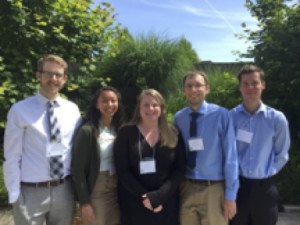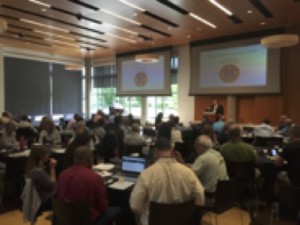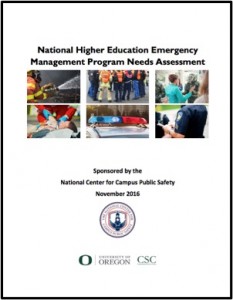By Amy Henson
The Oregon Disaster Resilient Universities Network (DRU) is a network of over 1,600 campus emergency management professionals connected through a listserv hosted by the University of Oregon. DRU is one of the partners CPW is collaborating with to develop the National Emergency Management Needs Assessment. As part of the National Needs Assessment, sponsored by the National Center for Campus Public Safety (NCCPS), we had scoped a DRU summit to explore the results of our needs assessment survey and better understand issues that campus emergency management programs face.
 In fall 2015, as a response to the tragic events at Umpqua Community College, Governor Kate Brown established a campus safety workgroup with the charge to identify resource needs and potential state policy to enable a coordinated strategy across the higher education system, both public and private institutions. Governor Brown appointed Andre Le Duc, the UO’s Chief Resilience Officer, to chair the committee. As it turns out, Le Duc is also on the board of the NCCPS.
In fall 2015, as a response to the tragic events at Umpqua Community College, Governor Kate Brown established a campus safety workgroup with the charge to identify resource needs and potential state policy to enable a coordinated strategy across the higher education system, both public and private institutions. Governor Brown appointed Andre Le Duc, the UO’s Chief Resilience Officer, to chair the committee. As it turns out, Le Duc is also on the board of the NCCPS.
Since our work with NCCPS included a summit and the Governor’s Workgroup was in an information gathering phase, Le Duc proposed we combine the DRU summit with the Workgroup meeting. So, in conjunction with the University of Oregon Office of Emergency Management and Continuity, we took part in the planning and facilitation of the event. We were excited to be part of the statewide campus safety effort, especially since we had been working on the national needs assessment project, and agreed to participate!
The CPW team hosted the Summit and it went GREAT! The CPW team, as well as CSC faculty, worked as facilitators through the all-day summit. Due to the abundance of facilitators, we were able to effectively register the participants, hand out nametags, direct participants to tables, and begin forming relationships with our guests for the day. After an introduction of the day and a brief background of the participating organizations by Andre Le Duc, the agenda really got started.
We assigned participants to tables with practitioners from other departments and other schools. We did this to engage conversations that may not occur in their regular professional setting. In order to ensure that participants were engaged in the process, the facilitators sat at each table and started with some brainstorming questions before probing into more detail. It was also valuable to keep the tables the same through the day; each table had a sense of camaraderie with those who they sat next to. We also provided a very loose schedule with breaks and a full hour lunch which allowed f or casual conversation and networking. We scheduled a burrito bar for lunch, to ensure positive attitudes would continue through the afternoon.
or casual conversation and networking. We scheduled a burrito bar for lunch, to ensure positive attitudes would continue through the afternoon.
The day began with a presentation of the preliminary findings from a national needs assessment survey administered by our CPW team. In analyzing the findings, the team grouped the needs into four theme areas: institutional commitment, staffing, training & exercises, and plans & continuity. We used these themes throughout the day and through facilitated conversation were able to parse out the needs that all of Oregon’s campuses have, regardless of size, popular majors, or whether they are public or private. After the CPW team presented, we then welcomed speakers on the topics of preparedness, continuity, response, and recovery.
After each speaker, the participants took part in table discussions, facilitated by CSC/CPW team. Each participant received a worksheet to fill out, providing the opportunity to share thoughts in various manners. We wanted to ensure that no matter how people chose to express themselves, we would be able to cater to those styles. The facilitators allowed the table groups to discuss the various components of need in their universities, and stepped in only when the conversation drifted too far from the original topic, or if participants struggled to find the “jumping off” point of the conversation.
While there were some things I would definitely change in the day (it was seven hours, the conversations got a little redundant at the end, etc.), but overall, it was great day. The conversations that occurred and the relationships that were forged could not have been any better. I think that if we can continue to build on this work, Oregon and her students will have a safer and more prepared future. I look forward to continuing working with the work group through the rest of the summer.

Amanda (Amy) Henson is a second year Master’s of Public Administration student, focusing in higher education administration and policy. She enjoys hot coffee, cold ice cream, and spontaneous weekend adventures.




